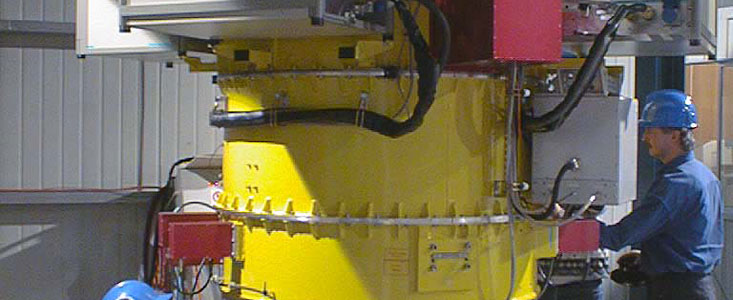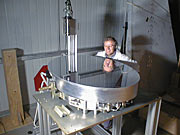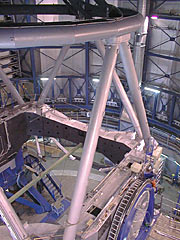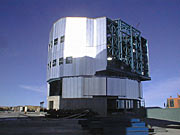Nota de Imprensa
Recent News from the VLT Project
12 de Agosto de 1998
The ESO Very Large Telescope (VLT) project progresses rapidly. The first part of the Commissioning Phase for the first 8.2-m VLT Unit Telescope (UT1), concerning the Cassegrain focus and including optimization of the telescope performance, is now coming to an end. The next is dedicated to science observations and will start in a few days. This photo release provides information about the current activities and includes some recent photos from the Paranal observatory.
Science Verification About To Start
A two-week period of Science Verification will begin on August 17, 1998. This will involve actual astronomical observations with the VLT Test Camera. There will be several research projects, including deep imaging observations of fields in the HDF-South area.
A full description of the programmes selected for the Science Verification will also be found in an article in the June 1998 issue of the ESO Messenger.
Meanwhile, the first Call for Observing Proposals for the VLT UT1 has been issued with deadline on October 1, 1998 . It concerns the six-month period from April - September 1999 and involves the use of two major instruments, FORS1 and ISAAC (see below). In view of the great interest in the VLT and its potential for front-line research, it is expected that the pressure to obtain observing time will be high. Note also the VLT P63 Proposal Submission: Late Breaking News website.
Two Large Astronomical Instruments Now on Paranal
The first FOcal Reducer/low dispersion Spectrograph (FORS1) was sent by plane to Santiago de Chile on July 4, 1998, well packed in 22 boxes. After a two-day trip on the Panamericana, it arrived at the base camp on Cerro Paranal in the afternoon of July 10. The FORS team from Göttingen, Heidelberg and Munich (Germany) started unpacking and re-integration of instrument sections next day in the Auxiliary Telescope Hall . Functional tests of the integrated sections were performed during the following days with excellent results. In particular, the delicate Multi-Object Spectroscopy system worked perfectly. Then the test crew for special verification and alignment work took over; these activities were successfully finished on August 7. See the photo and check the FORS Integration website.
FORS1 is now ready for the transport to the first 8.2-m VLT telescope (UT1)on September 10. It will then be installed at the telescope and 'First Light' of FORS1 will happen immediately thereafter. Then follows two Commissioning Phases to demonstrate the proper functioning of FORS1 in the environment at the telescope. Thereafter, FORS1 has to prove its scientific capabilities during a Science Verification Phase in mid-January 1999. It will then be offered for use by the astronomical community as from April 1999.
The second major instrument to be mounted on UT1, the VLT Infrared Spectrometer And Array Camera (ISAAC), arrived by air in Santiago on June 5, 1998 and reached Paranal three days later in a specially escorted convoy of two large trucks. To minimize the risk of transport damage to its delicate optics, the instrument had been disassembled after testing in Garching and its sub-assemblies spring mounted in special transport containers.
A team from ESO's Instrumentation Division in Garching arrived a week later to unpack, re-integrate, align and test this highly complex instrument in the Integration Laboratory on the mountain. After about 12 days, all was ready to evacuate the large vacuum vessel and cool the 350 kg opto/mechanical assembly to cryogenic temperatures using liquid nitrogen and closed cycle coolers mounted on the instrument.
A series of functional tests of the instrument plus its two large racks of electronics and software were then made followed by detector performance and other tests. In parallel, the large maintenance carriage and co-rotator systems were installed on the Nasmyth platform of UT1 in preparation for the later installation of the instrument. As ISAAC will be attached to and rotate with the Nasmyth adapter, this co-rotator is required to transport several kilometres of cables and cooling hoses from the platform mounted electronics racks, pumps and compressor to the instrument.
Final tests and calibrations of ISAAC will be made in October, followed by installation on the telescope and the first phase of testing on the sky starting on November 14, 1998. Final commissioning plus science verification observations are planned during a 3-week period in February 1999 and the first visiting astronomers are expected in early April 1999.
Other Work
The following electronic photos illustrate other recent work at Paranal observatory.
Sobre a Nota de Imprensa
| Nº da Notícia: | eso9837 |
| Legacy ID: | Photo 30a-e/98 |
| Nome: | FORS1, ISAAC, Very Large Telescope, VLT Unit Telescopes |
| Tipo: | Unspecified : Technology : Observatory : Telescope Unspecified : Technology : Observatory : Instrument |
| Facility: | Very Large Telescope |
Our use of Cookies
We use cookies that are essential for accessing our websites and using our services. We also use cookies to analyse, measure and improve our websites’ performance, to enable content sharing via social media and to display media content hosted on third-party platforms.
ESO Cookies Policy
The European Organisation for Astronomical Research in the Southern Hemisphere (ESO) is the pre-eminent intergovernmental science and technology organisation in astronomy. It carries out an ambitious programme focused on the design, construction and operation of powerful ground-based observing facilities for astronomy.
This Cookies Policy is intended to provide clarity by outlining the cookies used on the ESO public websites, their functions, the options you have for controlling them, and the ways you can contact us for additional details.
What are cookies?
Cookies are small pieces of data stored on your device by websites you visit. They serve various purposes, such as remembering login credentials and preferences and enhance your browsing experience.
Categories of cookies we use
Essential cookies (always active): These cookies are strictly necessary for the proper functioning of our website. Without these cookies, the website cannot operate correctly, and certain services, such as logging in or accessing secure areas, may not be available; because they are essential for the website’s operation, they cannot be disabled.
Functional Cookies: These cookies enhance your browsing experience by enabling additional features and personalization, such as remembering your preferences and settings. While not strictly necessary for the website to function, they improve usability and convenience; these cookies are only placed if you provide your consent.
Analytics cookies: These cookies collect information about how visitors interact with our website, such as which pages are visited most often and how users navigate the site. This data helps us improve website performance, optimize content, and enhance the user experience; these cookies are only placed if you provide your consent. We use the following analytics cookies.
Matomo Cookies:
This website uses Matomo (formerly Piwik), an open source software which enables the statistical analysis of website visits. Matomo uses cookies (text files) which are saved on your computer and which allow us to analyze how you use our website. The website user information generated by the cookies will only be saved on the servers of our IT Department. We use this information to analyze www.eso.org visits and to prepare reports on website activities. These data will not be disclosed to third parties.
On behalf of ESO, Matomo will use this information for the purpose of evaluating your use of the website, compiling reports on website activity and providing other services relating to website activity and internet usage.
Matomo cookies settings:
Additional Third-party cookies on ESO websites: some of our pages display content from external providers, e.g. YouTube.
Such third-party services are outside of ESO control and may, at any time, change their terms of service, use of cookies, etc.
YouTube: Some videos on the ESO website are embedded from ESO’s official YouTube channel. We have enabled YouTube’s privacy-enhanced mode, meaning that no cookies are set unless the user actively clicks on the video to play it. Additionally, in this mode, YouTube does not store any personally identifiable cookie data for embedded video playbacks. For more details, please refer to YouTube’s embedding videos information page.
Cookies can also be classified based on the following elements.
Regarding the domain, there are:
- First-party cookies, set by the website you are currently visiting. They are stored by the same domain that you are browsing and are used to enhance your experience on that site;
- Third-party cookies, set by a domain other than the one you are currently visiting.
As for their duration, cookies can be:
- Browser-session cookies, which are deleted when the user closes the browser;
- Stored cookies, which stay on the user's device for a predetermined period of time.
How to manage cookies
Cookie settings: You can modify your cookie choices for the ESO webpages at any time by clicking on the link Cookie settings at the bottom of any page.
In your browser: If you wish to delete cookies or instruct your browser to delete or block cookies by default, please visit the help pages of your browser:
Please be aware that if you delete or decline cookies, certain functionalities of our website may be not be available and your browsing experience may be affected.
You can set most browsers to prevent any cookies being placed on your device, but you may then have to manually adjust some preferences every time you visit a site/page. And some services and functionalities may not work properly at all (e.g. profile logging-in, shop check out).
Updates to the ESO Cookies Policy
The ESO Cookies Policy may be subject to future updates, which will be made available on this page.
Additional information
For any queries related to cookies, please contact: pdprATesoDOTorg.
As ESO public webpages are managed by our Department of Communication, your questions will be dealt with the support of the said Department.





